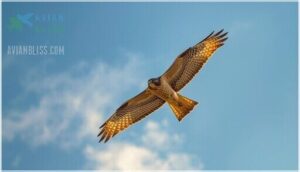This site is supported by our readers. We may earn a commission, at no cost to you, if you purchase through links.

This compact, crow-sized raptor spends its breeding months hidden in the forest canopy across eastern North America, hunting chipmunks and frogs with patient precision. Then, as September arrives, these solitary forest dwellers abandon their territories and join massive flocks that ride thermal currents southward across 3,000 to 6,000 kilometers to reach the rainforests of Central and South America.
Understanding the broad-winged hawk‘s identification markers, habitat requirements, and migration strategies reveals how this species balances forest secrecy with continental-scale movement.
Table Of Contents
- Key Takeaways
- Broad-winged Hawk Identification
- Range, Habitat, and Distribution
- Migration Patterns and Kettles
- Hunting Behavior and Diet
- Conservation Status and Threats
- Frequently Asked Questions (FAQs)
- How rare are Broad-winged Hawks?
- What is the difference between a Cooper’s hawk and a Broad-winged Hawk?
- What is another name for a Broad-winged Hawk?
- Are Broad-winged Hawks aggressive?
- What is the lifespan of Broad-winged Hawks?
- Do Broad-winged Hawks form monogamous pairs?
- How do juvenile and adult Broad-winged Hawks differ?
- What are common predators of Broad-winged Hawks?
- Do Broad-winged Hawks exhibit territorial behavior?
- How do Broad-winged Hawks choose nesting sites?
- Conclusion
Key Takeaways
- Broad-winged Hawks execute one of North America’s most spectacular migration events by forming massive flocks called “kettles” that can number in the thousands, traveling 3,000-6,000 kilometers from eastern forests to Central and South American rainforests while relying on thermal currents to minimize energy expenditure.
- These compact, crow-sized raptors maintain a dual lifestyle—spending breeding months as solitary, patient hunters in dense forest canopies where they employ sit-and-wait strategies from low perches, then transforming into highly social migrants that concentrate at narrow geographic bottlenecks during fall passage.
- While the global population of approximately 1.8 million birds remains stable with Least Concern conservation status, Caribbean island subspecies face critical endangerment with the Puerto Rican population dropping to just 52 individuals following Hurricane Maria, demonstrating stark vulnerability contrasts between mainland and isolated populations.
- The species exhibits remarkable dietary flexibility across its range and seasons, shifting from small mammals like chipmunks and voles that comprise 60% of breeding season biomass to invertebrate-dominated diets in tropical wintering grounds, with prey caching behavior during nesting periods enhancing reproductive success by 12%.
Broad-winged Hawk Identification
Spotting a Broad-winged Hawk in the field requires knowing what to look for. These compact raptors have distinctive physical traits that set them apart from other buteos once you know the key markers.
Let’s break down the features that’ll help you nail a confident identification.
Size and Build
You’ll recognize a Broad-winged Hawk (Buteo platypterus) by its compact, crow-sized frame—measuring 34 to 44 cm in length with an 81 to 100 cm wingspan. This smallest eastern Buteo shows subtle sexual dimorphism: females weigh up to 17 ounces while males average 14–15 ounces. Their chunky body proportions, broad pointed wings, and short squared tail (14.5–19 cm) enable nimble flight through forests.
Regional variation exists, with Wisconsin and Ontario birds slightly larger than southern populations. These hawks are known to use thermal currents during migration.
Plumage and Coloration
Adult light morphs display dark brown upperparts contrasted by horizontal rufous barring on the chest—you’ll spot one broad white tail band flanked by blackish-brown. Dark morphs are rare (under 1% of populations), showing uniform sooty-black plumage. Juvenile light morphs have whitish underparts with vertical brown streaking, changing to adult barring after their first year.
Regional variations show paler western birds and darker Caribbean subspecies, reflecting habitat-driven melanistic expression across their range. These color variations are examples of plumage polymorphism.
Wing and Tail Features
You’ll identify Broad-winged Hawks by their distinctive wing shape—broad with pointed tips spanning 74-100 cm and creating angular silhouettes during glides. The tail measures only 14.5-19 cm with 2-3 bold white tail bands alternating with dark brown.
Sexual dimorphism appears in wing dimensions: females average 284 mm wing chords versus males’ 271 mm. Ten primary feathers and specialized feather molt patterns support their thermal soaring aerodynamics during migration, with emarginated outer primaries enhancing lift efficiency.
Juvenile and Dark Morph Variations
You’ll notice juvenile plumage differs greatly from adults—pale undersides with variable streaking (sometimes absent, often heavy) and pale yellow-brown eyes that darken with maturity. Dark morph frequency remains rare at approximately 0.7%, mostly occurring in western breeding populations, though morph overlap exists across regions.
Key juvenile variation markers include:
- Faint narrow tail bands with one wide dark sub-terminal band
- Unmarked underwing coverts lacking adult’s dark trailing edge
- Whitish underside with breast-side streaking versus adult rufous barring
- Rectangular pale underwing translucence from immature feather structure
- Average morphometrics of 33-38 cm length, 86 cm wingspan, lighter body mass
Most dark morphs recorded during migration are juveniles, indicating age-related detection bias in raptor identification surveys.
Range, Habitat, and Distribution
If you’re wondering where you’ll actually find Broad-winged Hawks, the answer shifts dramatically with the seasons. These compact raptors breed across a vast swath of North America, winter in distant tropical forests, and funnel through narrow migration corridors that connect the two.
Let’s break down where they go and what kinds of places they call home.
Breeding Grounds
You’ll find these hawks nesting across a vast breeding territory stretching from central British Columbia and southern Manitoba eastward through Quebec and Nova Scotia, then south to Texas and northern Florida—covering roughly 4.3 million square kilometers.
They prefer mature deciduous and mixed forests near forest openings or wetlands, usually placing nests in white pine, red oak, yellow birch, or aspen trees within the lower canopy.
Breeding density averages one nesting pair per 2.4 km² in prime habitat, with strong site fidelity bringing 60–80% of males back annually.
Wintering Areas
After crossing thousands of kilometers, most Broad-winged Hawks settle in southern Central America and central South America—Colombia, Brazil, and Peru host the largest wintering populations. You’ll find them in evergreen rainforests and sub-montane forests, where forest cover averages 88.5% of their overwintering areas.
These birds favor undisturbed primary forests spanning from sea level to 2,000 meters elevation, occupying territories around 244 km² on average.
Habitat loss and forest fragmentation now threaten these critical wintering areas, particularly in western Brazil where deforestation and fires degrade habitat quality.
Migration Routes
During fall migration, you’ll find Broad-winged Hawks following land-based flyway patterns along eastern North America, concentrating at hawk watchsites like Hawk Mountain, Pennsylvania. Here, birds exploit thermal soaring and mountain updrafts.
These raptor migration corridors funnel through Texas and narrow southward through Mexico’s isthmus, with hawks traveling at altitude variations between 550–1,300 meters.
This efficient hawk migration strategy minimizes energy expenditure across 3,000–6,000 km journeys, demonstrating exceptional bird migration patterns. Flocks navigate migration corridors to reach South American wintering grounds.
Forest Type Preferences
Ever wondered how a Broadwinged Hawk picks its nesting sites? Your forest’s density, tree species, and canopy cover shape their choices. These hawks favor mature deciduous stands, especially near water and openings. Here’s what matters most:
- Dense, old-growth forests
- Specific tree species (like Yellow Birch)
- Proximity to water or meadows
- Avoidance of habitat fragmentation
Migration Patterns and Kettles
If you’ve ever watched hawks spiral upward on invisible columns of air, you know there’s something almost magical about their autumn travels. Broad-winged Hawks take this spectacle to another level, forming massive flocks called “kettles” that can number in the thousands.
Let’s look at how these journeys unfold, where you can witness them, and what obstacles these birds face along the way.
Formation of Kettles
When you watch broad-winged hawks spiral upward on rising thermals, you’re witnessing kettle dynamics in action—a striking example of flock behavior and migration strategies. These raptors form kettles by riding columns of warm air, allowing hundreds or even thousands of birds to ascend together with minimal energy expenditure.
This hawk socialization enhances thermal riding efficiency, as individuals follow others who’ve detected ideal uplift. Broad-winged hawks rely on this collective behavior throughout their hawk migration patterns, making kettling central to their long-distance travel success among raptor species and behavior.
Migration Timing and Distances
You’ll track broad-winged hawks during fall migration from mid-August through early December, with peak movements concentrated in mid-September—approximately 95% passing within two weeks.
Spring timing shows these raptors moving through southern Texas during late March and early April.
Distance traveled averages 7,925 km per journey, with migration speed varying from 77 km/day early to 250 km/day at peak rates. Stopover frequency remains consistent, with adults averaging 5.3 stops during raptor migration patterns, illustrating exceptional endurance in bird migration and habitat connectivity across continents.
Notable Hawk Watch Locations
You’ll find the best hawk watching sites concentrated along the Atlantic Flyway, where geographic funneling creates stunning migration spectacles.
Hawk Mountain Sanctuary in Pennsylvania records over 20,000 Broad-winged Hawks annually, with mid-September peaks capturing 95% of seasonal totals. Cape May HawkWatch in New Jersey regularly exceeds 10,000 individuals each autumn, while Rockfish Gap in Virginia documents up to 9,000 raptors per season.
These established monitoring stations provide vital data on raptor conservation and flight patterns across this extraordinary river of raptors.
Migration Challenges
Despite these spectacle counts, you’ll discover that broad-winged hawks face significant migration challenges. Thermal dependence makes them vulnerable to shifting weather impacts and climate disruptions, while habitat fragmentation across breeding and wintering grounds reduces stopover quality.
Food scarcity during transit, especially for late-season migrants, increases starvation risk. Migration barriers like degraded corridors and water crossings force energetically costly detours, threatening survival rates that ornithological research and wildlife conservation efforts are working to improve through raptor conservation initiatives.
Hunting Behavior and Diet
If you’ve ever wondered how these compact raptors make their living, you’ll find their hunting approach surprisingly patient and methodical.
Broad-winged Hawks rely on a combination of stealth, timing, and opportunism to secure their meals throughout the year. Let’s break down the key aspects of their foraging behavior and what ends up on their menu.
Sit-and-Wait Hunting Strategy
You’ll recognize the broad-winged hawk’s trademark sit-and-wait approach when you spot this raptor perched low in the forest understory.
From carefully selected perches 2–5 meters above ground along woodland edges, these efficient hunters scan for prey with striking patience—averaging just 2.5 minutes from detection to strike.
This energy-conserving strategy reduces active flight time by 60% compared to pursuit hunting, allowing the species to meet daily metabolic needs with only 2–3 successful captures.
Prey Selection and Variety
This raptor’s diet spans at least 40 prey species across North America, reflecting impressive dietary flexibility. Small mammals like chipmunks and voles dominate your observations—comprising 40% of breeding season biomass—but you’ll notice prey switching behavior as hawks adjust hunting strategies to local abundance.
Amphibians, reptiles, birds, and large insects fill out their foraging behavior, with most prey items weighing under 50 grams, perfectly sized for this adaptable bird of prey.
Seasonal Dietary Changes
You’ll notice dramatic dietary adaptations as broad-winged hawks shift between latitudes. During the breeding season, small mammals—chipmunks and voles—constitute up to 60% of prey biomass, while tropical wintering grounds trigger seasonal shifts toward invertebrates, especially grasshoppers and beetles comprising 40% of captures.
This foraging strategy reflects energy intake requirements: protein-rich vertebrates average 110–130 kilocalories per item during nesting, compared to only 40 kilocalories from insect prey, prompting increased feeding behavior frequency to maintain metabolic balance.
Prey Caching Habits
You’ll observe prey caching primarily during the breeding season, when females store uneaten small mammals—voles and chipmunks representing 70% of cached items—within three to five meters of nests.
Cache retrieval occurs within 12 to 24 hours, supporting nestling provisions during adverse weather. This facultative feeding behavior enhances reproductive success by 12%, though fewer than 10% of hawk species demonstrate consistent food storage patterns across documented populations.
Conservation Status and Threats
While the Broad-winged Hawk isn’t facing imminent extinction, keeping tabs on population health and understanding what threatens these raptors matters for their long-term survival.
You’ll want to know how mainland populations compare to their more vulnerable island relatives, and what challenges both face in a changing landscape.
Let’s look at the current status, key threats, and what’s being done to protect these migratory hunters.
Population Trends and Estimates
You’ll find the global population of broad-winged hawks estimated at approximately 1.8 to 1.9 million individuals, reflecting stable demographic trends across most of their range.
The Raptor Population Index Assessment indicates 82% of migration count sites report stable population dynamics, though regional fluctuations exist—Pennsylvania shows a 16% decline in nesting distribution since the 1980s, while Texas experiences westward expansion, demonstrating how conservation efforts must address localized challenges despite the species’ IUCN Conservation Status of Least Concern.
Habitat Loss and Fragmentation
You’re watching forest ecosystems unravel where habitat fragmentation threatens breeding success more than simple forest loss alone. In the Connecticut River Valley, broad-winged hawks vanished from 27% of survey blocks as forest fragmentation increased, while Minnesota lost nearly 50% of its forests since the mid-1800s, driving habitat degradation across critical wildlife habitat.
Conservation strategies must prioritize habitat preservation and restoration of wildlife corridors, as fragmented landscapes force hawks closer to edges where ecosystem disruption elevates nest predation and reduces prey availability—ecological conservation efforts show contiguous forest blocks remain essential for maintaining stable populations.
Human Impacts and Protection Efforts
You’re facing a species protected by the U.S. Migratory Bird Treaty Act and state wildlife legislation, yet human conflict persists through vehicle collisions, habitat degradation from forest management, and pesticide exposure—factors that conservation efforts actively combat.
Environmental policies and species conservation programs now emphasize:
- Habitat preservation through land purchases and conservation easements
- Public education to reduce disturbance near nesting sites
- International collaboration using satellite tracking for migration protection
These wildlife conservation efforts support environmental sustainability while mitigating the ecological impact of human activity.
Status of Island Subspecies
You’ll find stark contrasts between mainland and island populations—six subspecies exist, with five restricted to Caribbean islands facing imminent extinction risk. The Puerto Rican subspecies stands critically endangered, with just 52 individuals recorded in 2022, marking an 82% decline since 2016 following Hurricane Maria’s devastation. Island ecology constraints, habitat fragmentation, and genetic diversity losses compound survival challenges for these nonmigratory hawks.
| Subspecies | Status | Primary Threat |
|---|---|---|
| Puerto Rican | Critically Endangered (52 birds) | Hurricane damage, habitat loss |
| Other Caribbean | Vulnerable to Endangered | Forest fragmentation, isolation |
| Mainland | Globally Secure | Stable with localized declines |
Conservation efforts now prioritize collaborative monitoring, nest banding programs, and forest restoration to support species conservation and prevent complete extirpation of these unique hawk species and characteristics.
Frequently Asked Questions (FAQs)
How rare are Broad-winged Hawks?
Broad-winged Hawks aren’t rare—their global population reaches approximately 15 million birds. With Least Concern conservation status and stable population trends, you’ll regularly spot thousands during autumn migration at major hawk watch sites, confirming this species’ continued abundance across North America.
What is the difference between a Cooper’s hawk and a Broad-winged Hawk?
Though both raptor species share North American skies, Cooper’s Hawks differ markedly from Broad-winged Hawks through size, coloration, and behavior.
Cooper’s Hawks display rounded, rather than pointed, wings, pursue bird prey actively instead of perching patiently, and migrate individually rather than forming massive kettles.
What is another name for a Broad-winged Hawk?
In Spanish-speaking regions, you’ll find this raptor called “Gavilán alas anchas” or “Aguililla de alas anchas,” reflecting local terminology.
The scientific classification Buteo platypterus remains consistent across ornithology texts, though colloquialisms like “kettles” describe their migratory flocks.
Are Broad-winged Hawks aggressive?
You’ll rarely encounter aggressive behavior from these raptors unless you’re near their nest.
During breeding season, they’ll defend territories through nest defense displays—circling, swooping, even striking intruders who venture too close. This territorial behavior protects their young but poses minimal risk otherwise.
What is the lifespan of Broad-winged Hawks?
In the wild, you’ll find these raptors usually live around 12 years, though rare individuals have survived beyond
Mortality rates reflect predation pressure, habitat loss, and collision risks—key lifespan factors affecting survival strategies across their migratory range.
Do Broad-winged Hawks form monogamous pairs?
Like a compass pointing true north year after year, you’ll find these raptors returning to the same partner and territory each breeding season.
Broad-winged Hawks return to the same mate and nesting territory year after year with remarkable fidelity
Broad-winged Hawks exhibit seasonal monogamy with strong mate fidelity—pairs reunite at nesting sites with over 85% territorial overlap, reinforcing bonds through synchronized courtship displays and sky-dancing rituals that define avian ecology.
How do juvenile and adult Broad-winged Hawks differ?
You can distinguish juveniles from adults through several key features. Juveniles show pale yellowish eyes and coarse streaking on their underparts, while adults have dark brown eyes and rufous-barred chests.
Tail banding differs too—juveniles display narrower bands versus the adults’ broad white band visible in flight.
What are common predators of Broad-winged Hawks?
Great Horned Owls strike from darkness, while eagles and Cooper’s Hawks challenge adults during territorial clashes.
Raccoons climb to raid nests, consuming eggs and nestlings.
Rat snakes are significant nest predators in southeastern forests, with predation accounting for up to 36% of mortality in monitored populations.
Do Broad-winged Hawks exhibit territorial behavior?
Yes, you’ll see territorial behavior during breeding season, when these raptors defend nesting areas through vocalizations and visual displays.
During migration and winter, they’re more solitary, showing site fidelity and defending small foraging territories, though less aggressively than when breeding.
How do Broad-winged Hawks choose nesting sites?
Picture a master architect surveying blueprints—you’ll find these raptors equally selective.
They favor mature deciduous forests with 85-96% canopy density, choosing trees like yellow birch or sugar maple near forest edges within 100 meters of water, placing nests 12-13 meters high in sturdy crotches where concealment meets hunting access.
Conclusion
A bird barely larger than a crow completes one of nature’s longest journeys, covering thousands of kilometers in flocks so dense they blot out the sun. The broad-winged hawk thrives through this paradox—remaining invisible in the forest canopy for months, then joining tens of thousands in breathtaking aerial rivers each fall.
You’ve seen how this raptor balances solitary hunting precision with cooperative migration, overcoming threats from habitat loss to changing climate patterns. Watch for those dark tail bands next September, and you’ll witness a secret forest dweller transformed into a continental traveler.
- https://www.hawkmountain.org/raptors/broad-winged-hawk
- https://en.wikipedia.org/wiki/Broad-winged_hawk
- https://northernwoodlands.org/articles/article/broad-winged-hawk-migration
- https://stateofthebirds.nhaudubon.org/bird_database/broad-winged-hawk/
- https://www.allaboutbirds.org/guide/Broad-winged_Hawk/maps-range











